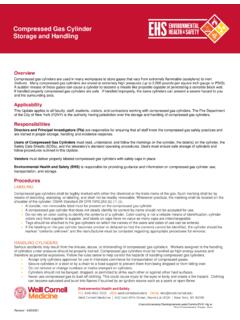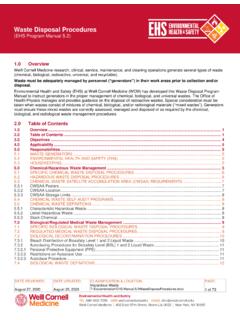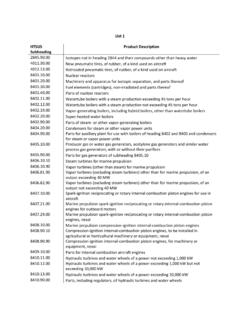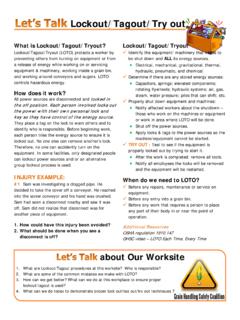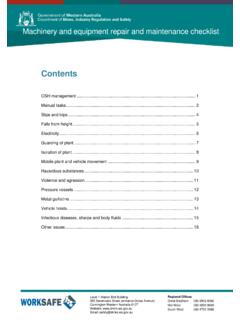Transcription of Physical Hazards of Machinery and Equipment
1 Physical Hazards of Machinery and Equipment Overview Safeguards are essential for protecting workers from needless and preventable Machinery -related injuries. Physical Hazards associated with the operation of mechanical Equipment and Machinery that users must be protected from include pinch points, wrap points, shear points, crush points, pull-in points, and the potential for objects to be thrown from the Equipment . While it is not always possible to achieve complete protection from Machinery Hazards , the point of operation, and all parts of the machine that move while the Equipment is operating, must be safeguarded if possible. A good rule to remember is: Machine operators must be safeguarded from any machine part, function, or process that may cause injury. It is important that Equipment users follow the safety practices below before operating Equipment : Training must be completed by all users on the piece(s) of Equipment in their workspace.
2 Users should avoid working alone. Machine guarding must be in place and functioning properly. Report machine guarding problems to a supervisor immediately. Loose clothing and hair, including neckties, must be secured around Equipment . Dangling jewelry, such as necklaces, earrings, and non-breakaway lanyards, must be removed when around Equipment . Long hair must be tied back and secured. Proper personal protective Equipment (PPE) including gloves and eye, face, and/or hearing protection, if required, must be worn. Applicability This update applies to anyone operating Machinery at Weill Cornell Medicine (WCM), including all employees, students, and volunteers working in laboratory, clinical, administrative, or service work environments. The requirements listed in this document apply but are not limited to, machine tools, mechanical Equipment , laboratory Equipment , and other areas where Machinery presents a Physical hazard that may cause injury to users.
3 Additionally, this update covers all Equipment that contains pinch points, wrap points, shear points, crush points, pull-in points, or the potential to throw objects. The scope of these procedures is not limited to machine shops, but extends to all Machinery and/or tools utilized in WCM spaces. Physical Hazards Associated with Machinery Pinch Points Any point other than the point of operation at which a part of the body could be caught between the moving parts of a press or auxiliary Equipment , between moving and stationary parts of a press or auxiliary Equipment , or between the material and moving part or parts of the press or auxiliary Equipment . Also called mesh points, run-on points, and entry points. Examples include belt drives, chain drives, gear drives, and feed rolls. When shields cannot be provided, operators must avoid contact with hands or clothing in pinch point areas. Never attempt to service or unclog a machine while it is operating or the engine is running.
4 Wrap Points Any exposed component that rotates and where loose clothing or body parts could become entangled. Examples include rotating shafts such as a PTO shaft, or shafts that protrude beyond bearings or sprockets. Watch components on rotating shafts, such as couplers, universal joints, keys, keyways, pins, or other fastening devices. Splined, square, and hexagon-shaped shafts are usually more dangerous than round shafts because the edges tend to grab fingers or clothing more easily than a round shaft. However, round shafts may not be smooth and can also grab quickly. Once a finger, thread, article of clothing, or hair is caught it begins to wrap; pulling only causes the wrap to become tighter. Updated April 2020 T:\Documentation\EHS-Updates\ CONTINUED: Physical Hazards of Machinery and Equipment Shear Points Any point where sharp edges of two moving parts move across one another, or where a single sharp part moves with enough speed or force to cut soft material.
5 Cutting devices cannot be completely guarded to keep hands and feet out and still perform their intended function. Equipment not designed to cut or shear may still have cutting and shearing Hazards . Additional precautions are needed when guarding is not possible. Crush Points Points that occur between two objects moving toward each other or one object moving toward a stationary object. Never stand between two objects moving toward one another. Use adequate blocking or lock-out devices when working inside or under Equipment . Pull-In Points Points where objects are pulled into Equipment , usually for some type of processing. Never attempt to hand-feed materials into moving feed rollers. Always stop and lock out the Equipment before attempting to remove an item that has plugged a roller, or that has become wrapped around a rotating shaft. Remember that guards cannot be provided for all situations and will not be utilized if they interrupt the Equipment 's ability to function in the capacity for which it is designed.
6 Freewheeling parts or rotating or moving parts that continue to move after power is shut off, are particularly dangerous because time delays are necessary before service can begin. Allow sufficient time for freewheeling parts to start moving. Always stay alert and listen and watch for motion. Thrown Objects Any object or piece of an object that can become airborne because of moving parts. Keep shields in place to reduce the potential for thrown objects. Wear protective gear such as safety glasses to reduce the risk of personal injury if you cannot prevent particles from being thrown. All guards, shields or access doors must be in place when Equipment is operating. Electrically powered Equipment must have a lock-out control on the switch or an electrical switch, mechanical clutch, or other positive shut-off device mounted directly on the Equipment . Circuit interruption devices on an electric motor, such as circuit breakers or overload protection, must require manual reset to restart the motor.
7 Responsibilities Supervisors must: Ensure that Equipment users have been properly trained to operate Equipment and Machinery in a safe manner. Verify that all Equipment is inspected regularly to ensure its proper operation and that all guarding is in place and functional. Correct all machine guard deficiencies immediately. Remove any damaged Equipment from service. Equipment users must: Only operate Equipment for which they have received training. Ensure that all guards are in place before operating Machinery or Equipment . Confirm that all hazardous energy from the Equipment has been properly controlled before servicing Equipment . Perform service and maintenance on Equipment . This should only be done for machines which they have been appropriately trained in Equipment use and relevant energy control procedures. Verify that all service and maintenance is performed in accordance with the manufacturer's guidelines. Report all machine guard problems, malfunctioning, and/or damaged Equipment to their supervisor immediately.
8 2. CONTINUED: Physical Hazards of Machinery and Equipment Environmental Health and Safety (EHS) must: Provide technical assistance and guidance on machine guarding, as well as supplemental machine guarding awareness training for Equipment users and supervisors. Establish Physical hazard Safety Guidelines for Machinery . Inspects areas using Machinery and mechanical Equipment for compliance. Requirements for Safeguards Moving machine parts have the potential to cause death or severe workplace injuries, such as crushed fingers or hands, amputations, burns, or blindness. Safeguards are essential for protecting workers from needless and preventable injuries. When accidental contact with an operating machine can injure the operator or others in the vicinity, or if regular machine operation can result in injury, the hazard(s) must be either eliminated or controlled as thoroughly as feasibly possible. The following precautions (if applicable) must be considered when installing machine guards for all Equipment : Prevent contact - prevent worker's body or clothing from contacting hazardous moving parts.
9 Secure be firmly secured to the machine and not easily inadvertently removed. Protect from falling objects - ensure that no unintended objects can fall into moving parts. Create no new Hazards -must not introduce new shear points, jagged edges, or unfinished surfaces. Create no interference - allow the worker to perform the job quickly and comfortably. Allow safe lubrication - if possible, the machine should be able to be lubricated without removing the safeguards. Hazards to machine operators that cannot be guarded against must be shielded to protect the operator from injury or death, if possible, when taking the above precautions. Guards, decals, and labels that identify the danger must be kept in place whenever the machine is in operation. Guards or shields removed for maintenance must be properly replaced before use. Any machine where guards have been removed for maintenance must be in the off position while the guard is removed. Hands, fingers, clothing, and other objects not intended for the machine may not be placed in any moving parts.
10 Moving parts present the greatest hazard since they move fast as part of their normal operation, and often will not stop if obstructed. Training Supervisors must ensure Equipment users receive adequate training in the proper use of all Equipment used. Equipment user training must, at a minimum, address the following areas: Hazards associated with particular machines. How the safeguards provide protection and the Hazards for which they are intended. How and why to use the safeguards. How and when safeguards can be removed, and by whom. What to do if a safeguard is damaged, missing, or unable to provide adequate protection. Equipment users who will perform service or maintenance on Equipment must be adequately trained in these procedures prior to performing this work. EHS is available to provide general machine guarding awareness training in addition to the required training above for any WCM. Equipment user. Supervisors must contact Environmental Health and Safety to arrange awareness training.

